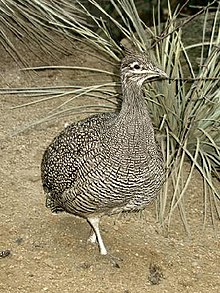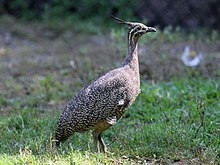Elegant crested tinamou
| Elegant crested tinamou | |
|---|---|

| |
| At the Bronx Zoo, New York City | |
| Scientific classification | |
| Domain: | Eukaryota |
| Kingdom: | Animalia |
| Phylum: | Chordata |
| Class: | Aves |
| Infraclass: | Palaeognathae |
| Order: | Tinamiformes |
| Family: | Tinamidae |
| Genus: | Eudromia |
| Species: | E. elegans
|
| Binomial name | |
| Eudromia elegans (Saint-Hilaire, 1832)[2]
| |
| Subspecies | |
|
E. e. elegans | |
| Synonyms | |

The elegant crested tinamou or martineta tinamou (Eudromia elegans) is a medium-sized tinamou that can be found in southern Chile and Argentina[6] in shrubland.[7]
Etymology
Eudromia comes from two Greek words, eu meaning well or nicely, and dromos meaning a running escape. These definitions together mean, nice running escape, which refers to their habit of escaping predators by running. Finally, elegans means neat or elegant, and martinete is Spanish for night heron because its elegant crest is reminiscent of a night heron's crest.[8]
Taxonomy

All tinamou are from the family Tinamidae, and in the larger scheme are also ratites. Unlike other ratites, tinamous can fly, although in general they are not strong fliers. All ratites evolved from prehistoric flying birds, and tinamous are the closest living relative of these birds.[9]
Isidore Geoffroy Saint-Hilaire first identified the elegant crested tinamou from a specimen from South America, in 1832.[9]
Subspecies[6]
- E. e. elegans, the nominate race, occurs in central Argentina; Neuquén and Rio Negro Provinces
- E. e. intermedia occurs in the Andes of northwestern Argentina; Salta and Catamarca Provinces
- E. e. magnistriata occurs in the Andes of northwestern Argentina; Tucumán and northern Córdoba Provinces
- E. e. riojana occurs in the Andes of northwestern Argentina; La Rioja and San Juan Provinces
- E. e. albida occurs in the dry savannah of western Argentina, in San Juan Province
- E. e. devia occurs at the base of the Andes in southwestern Argentina in Neuquén Province
- E. e. patagonica occurs in southern Argentina; Neuquén, Rio Negro, Chubut, and Santa Cruz Provinces and adjacent southern Chile; Biobío to Magallanes y la Antártica Chilena Provinces
- E. e. numida occurs in dry grasslands of central Argentina
- E. e. wetmorei occurs in the Andean foothills of north central Mendoza Province, western Argentina
Description

The elegant-crested tinamou averages 39 to 41 cm (15–16 in) long. The species is a dark or yellowish brown partridge-like bird with a short tail and wings, two white stripes on each side of its face and a long crest with an upward pointed tip. The feet have no hind toes and the bluish or greyish legs are short and strong, as they are highly terrestrial bird.
Habitat
The elegant crested tinamou is typically found in the lowland dry shrubland, also in the higher elevations (2,500 m (8,200 ft)), and farmland too.[7]
Behavior
The diet, during the winter, consists mainly of seeds, leaves, fruit and insects, but in the summer it eats mainly insects.
The nest is a hollow on the ground formed by both birds and situated close to a low bush.[10] The male incubates the eggs and raises the young. When the young chicks hatch, they are down-covered and can run. They leave the nest almost immediately.[10] This tinamou, unlike others, flocks regularly, especially in winter.
The call is a loud sad whistle.[9]
Conservation

Although this species is heavily hunted for food and sport, the elegant crested tinamou is not uncommon and has a large range of 1,400,000 km2 (540,000 sq mi).[7] It is evaluated as Least Concern of the IUCN Red List of Threatened Species.[1]
References
- ^ a b Template:IUCN
- ^ a b c d e f g h i j k Brands, Sheila (Aug 14, 2008). "Systema Naturae 2000 / Classification, Eudromia elegans". Project: The Taxonomicon. Retrieved 12 Feb 2009.[permanent dead link]
- ^ Birds of the Lower Uruguay (Concluded). Walter B. Barrows, The Auk, Vol. 1, No. 4 (Oct., 1884), description # 206, page 318, doi:10.2307/4067223 (Stable URL)
- ^ On the alimentary canal of the Martineta Tinamou (Calodromas elegans). FE Beddard, Ibis, Volume 32, Issue 1, January 1890, pages 61–66 , doi:10.1111/j.1474-919X.1890.tb06466.x
- ^ Dabbene, R. (1923-12) La Martineta ( Calopezus elegans ) en Santa Cruz (Patagonia). Hornero 003 (02) : 195a-195
- ^ a b Clements, James (2007). The Clements Checklist of the Birds of the World (6th ed.). Ithaca, NY: Cornell University Press. ISBN 978-0-8014-4501-9.
- ^ a b c BirdLife International (2008). "Elegant-crested Tinamou - BirdLife Species Factsheet". Data Zone. Retrieved 12 Feb 2009.
- ^ Gotch, A. F. (1995) [1979]. "Tinamous". Latin Names Explained. A Guide to the Scientific Classifications of Reptiles, Birds & Mammals. New York, NY: Facts on File. p. 183. ISBN 0-8160-3377-3.
- ^ a b c Davies, S.J.J.F. (2003). "Tinamous". In Hutchins, Michael (ed.). Grzimek's Animal Life Encyclopedia. Vol. 8 Birds I Tinamous and Ratites to Hoatzins (2nd ed.). Farmington Hills, MI: Gale Group. pp. 57–59, 66. ISBN 0-7876-5784-0.
- ^ a b Harrison, Colin; Greensmith, Alan (1993). "Non-Passerines". In Bunting, Edward (ed.). Birds of the World (First ed.). New York, NY: Dorling Kindersley. p. 43. ISBN 1-56458-295-7.

